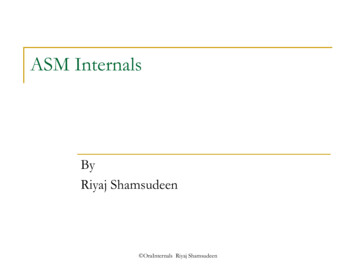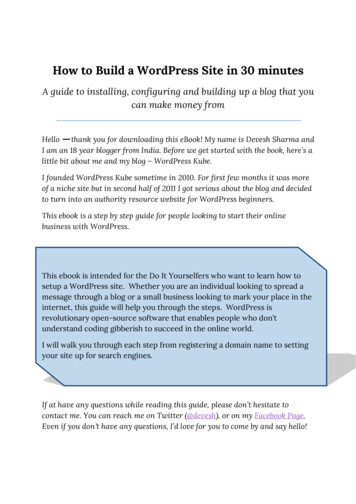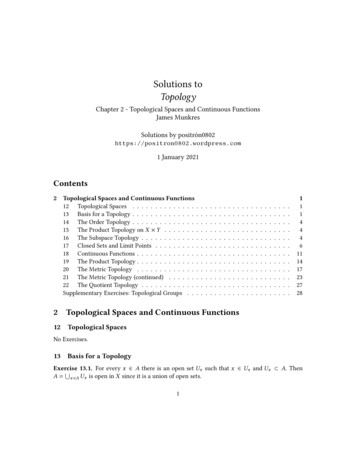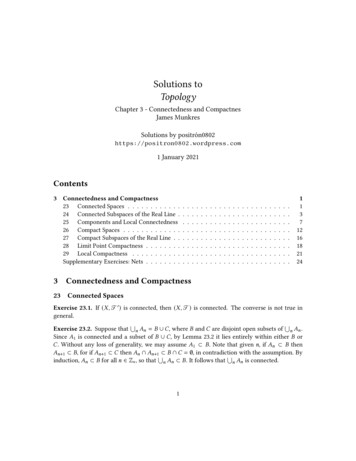
Transcription
ASM InternalsByRiyaj Shamsudeen OraInternals Riyaj Shamsudeen
Me 23 years as DBAOakTable memberOracle ACE DirectorSpecializes in RAC,performance tuning andInternals.Slowly in to BigData m Web: www.orainternals.com OraInternals Riyaj Shamsudeen2
WARNINGMost of the topics in this presentations are from my research.Writing about internals have issues:a. I completely misunderstood the data and trace files.b. Future version changed the feature, so, information is outdated.Tested in version 11g, 12.1.0.2, Linux and Solaris 11 platform.
AGENDAASM overview: Instance, asmb etcTools: kfod, kfed, amduDisk group, redundancy, AUASM rebalanceAsmcmdConclusion
Architecture ASM is an Oracle Instance with instance type ‘ASM’ ASM manages disks, luns and externalizes files to RDBMS ASM instance is never opened. Simply in a mount state.Demo: v instance OraInternals Riyaj Shamsudeen5
Architecture ASM provides an extent map of files to RDBMS. RDBMS directly accesses the disk to perform I/O. ASM isnot involved in I/O operation. Extending files or adding data files will involve refresh of extentmap from ASM to RDBMS.Demo: v instance OraInternals Riyaj Shamsudeen6
Architecture: With ASM OraInternals Riyaj Shamsudeen7
RDBMS I/O Truss of DBWR: ASM is not involved for RDBMS I/O to thedevices.Write calls to file pointer 262: (truss output)/1:kaio(AIOWRITE, 262 , 0x6DD3C000, 8192, 0xFC17E6380F4E4000) 0./1:kaio(AIOWRITE, 262 , 0x7DF3F000, 49152, 0xFC17D7080BD8A000) 0File pointer 262 is a SCSI device (pfiles output)262: S IFCHR mode:0755 dev:291,0 ino:15728902 uid:601 gid:503 rdev:30,129O RDWR O NONBLOCK O DSYNC O LARGEFILE FD n0001,1:b,raw OraInternals Riyaj Shamsudeen8
RDBMS is a client (aka umbilical process) asmb process running in RDBMS instance makes a connectionto ASM instance, as a foreground process for ASM instance. asmb process sleeps in a loop and a primary mechanism to detectASM crash. If ASM instance crashes, asmb connection will die leading to anRDBMS instance crash.Demo: asm connections.sql, asm clients.sql OraInternals Riyaj Shamsudeen9
RDBMS as a client Truss of a RDBMS startup shows that a LOCAL connection wasmade to the ASM instance.1821: 2.9102 0,0x0E9ED510) Instance restart alone opens 6 different connections to ASMinstance. You need to set processes parameter appropriately.grep execvetruss startup.lst grep grid1821:2.91020.0015 execve("/u02/app/11.2.0/grid/bin/oracle", 0x0E8E87F0, 0x0E9ED510)argc 21941:8.87720.0019 execve("/u02/app/11.2.0/grid/bin/oracle", 0x0E8E8090, 0x0EA11970)argc 21966:10.08840.0019 execve("/u02/app/11.2.0/grid/bin/oracle", 0x0E8E8090, 0x0EA11970)argc 22002:12.71980.0020 execve("/u02/app/11.2.0/grid/bin/oracle", 0x0E8E7550, 0x0E99B220)argc 22010:13.16690.0020 execve("/u02/app/11.2.0/grid/bin/oracle", 0x0E8E7550, 0x0E99B220)argc 22066:29.02960.0024 execve("/u02/app/11.2.0/grid/bin/oracle", 0x0E8E7550, 0x0E99B220)argc 2 OraInternals Riyaj Shamsudeen10
Death of asmb process asmb process sleeps on “ASM background timer” with 5s sleepcycle.*** 2011-10-05 00:38:11.486WAIT #0: nam 'ASM background timer' ela 5001967 p1 0 p2 0 p3 0 obj# -1 tim 1247836548 I killed the connection from ASM instance, resulting in asmbprocess death, followed by RDBMS instance crashNOTE: ASMB terminatingErrors in file lrac1 asmb 1492.trc:ORA-15064: communication failure with ASM instanceORA-03113: end-of-file on communication channelProcess ID:Session ID: 30 Serial number: 3 ASMB (ospid: 1492): terminating the instance due to error 15064Demo: Killing asmb connection OraInternals Riyaj Shamsudeen11
ASM extent pointer array v sgastat shows the extent pointer array in the RDBMS. Thisarray is retrieved from ASM instance.select * from gv sgastat where name like '%ASM extent%’;INST ID POOLNAMEBYTES---------- ------------ -------------------------- ---------1 shared poolASM extent pointer array1718242 shared poolASM extent pointer array171824 For large databases, this area will be bigger. To improve instance startup performance, only minimal extentmapping is retrieved initially. More data added to this array onneed basis. OraInternals Riyaj Shamsudeen12
Minimal ASM parameters Instance type ‘ASM’ASM instances named ASMx SGA components are:db cache size 64M # To cache metadata blocksshared pool size 128M # for various structures for ASMlarge pool size 64M # for extent map operations I usually, set processes parameter to 25 12*# of databases. 11g supports automatic memory management and you can setmemory target 512M and let Oracle manage it.Demo: Parameters, v sgastat, show sga OraInternals Riyaj Shamsudeen13
ASM disks During ASM startup, ASM instance scans the disks to identify allASM disks. Parameter asm diskstring identifies the disks to scan. asm diskstring accepts wildcard parameters and null is default.To improve ASM startup time, set this parameter properly. For example,Following value for asm diskstring will search for all devicesmatching the wildcard and has read write permissions.asm diskstring /dev/rdsk/c2t*d0s1Demo: show parameter asm diskstring OraInternals Riyaj Shamsudeen14
kfod Kfod –h for helpkfod utility can be used to check all devices that qualifiesasm diskstring. kfod status TRUE asm diskstring '/dev/mapper/' disks ALL verbose ---------------------------------DiskSize HeaderPathUserGroup 1:20473 Mb MEMBER/dev/mapper/asmdisk1p1oracleoinstall2:20473 Mb ---------------------ORACLE SID ORACLE HOME ASM1 /u01/app/12.1.0/gridKFOD-00311: Error scanning device /dev/mapper/controlORA-27041: unable to open fileLinux-x86 64 Error: 13: Permission deniedAdditional information: 42KFOD-00311: Error scanning device 7041: unable to open fileLinux-x86 64 Error: 13: Permission denied OraInternals Riyaj Shamsudeen15
ASM disks - RAC A lun must be visible in all nodes of a cluster with properpermissions for ASM to consider a lun.This means that lun path need not be the same, but lun shouldexist and visible through asm diskstring parameter.For example, same device have different names in two nodes:node1 /dev/rdsk/c2t9d0s1node2 /dev/rdsk/c2t11d0s1 ASM identifies Lun even if configuration changes later Metadata kept in every disk header.Demo: show parameter asm diskstring OraInternals Riyaj Shamsudeen16
kfed disk header kfed utility can be used to dump the metadata block(s) of thedevice. Without any parameter, kfed reads disk header. kfed read/dev/rdsk/c2t9d0s1kfbh.endian:1 ; 0x000: 0x01.kfbh.type:1 ; 0x002: KFBTYP at:0 ; 0x004: T 0 NUMB 0x02147483655 ; 0x008: TYPE 0x8 NUMB 0x7 186646528 ; 0x020: 0x0b200000kfdhdb.dsknum:7 ; 0x024: 0x0007kfdhdb.grptyp:1 ; 0x026: KFDGTP EXTERNALkfdhdb.hdrsts:3 ; 0x027: KFDHDR MEMBERkfdhdb.dskname:DATA 0007 ; 0x028: length 9kfdhdb.grpname:DATA ; 0x048: length 4kfdhdb.fgname:kfdhdb.capname:Demo: kfed readDATA 0007 ; 0x068: length 9; 0x088: length 0 OraInternals Riyaj Shamsudeen17
kfed.2kfdhdb.secsize:512 ; 0x0b8: 0x0200kfdhdb.blksize:4096 ; 0x0ba: 0x1000kfdhdb.ausize:1048576 ; 0x0bc: 0x00100000kfdhdb.mfact:kfdhdb.dsksize:113792 ; 0x0c0: 0x0001bc802000 ; 0x0c4: 0x000007d0kfdhdb.pmcnt:2 ; 0x0c8: 0x00000002kfdhdb.fstlocn:1 ; 0x0cc: 0x00000001kfdhdb.altlocn:2 ; 0x0d0: 0x00000002kfdhdb.f1b1locn:0 ; 0x0d4: 0x00000000kfdhdb.redomirrors[0]:0 ; 0x0d8: 0x0000kfdhdb.redomirrors[1]:0 ; 0x0da: 0x0000kfdhdb.redomirrors[2]:0 ; 0x0dc: 0x0000kfdhdb.redomirrors[3]:0 ; 0x0de: 0x0000kfdhdb.dbcompat:Demo: kfed read168820736 ; 0x0e0: 0x0a100000 OraInternals Riyaj Shamsudeen18
kfed other blocks kfed can be used to read other blocks in the lun also. kfed read/dev/rdsk/c2t9d0s1 aun 0 blkn 1 grep kfbh.typekfbh.type: kfed read2 ; 0x002: KFBTYP FREESPC/dev/rdsk/c2t9d0s1 aun 0 blkn 2 grep kfbh.typekfbh.type:3 ; 0x002: KFBTYP ALLOCTBL# ASM also stores backup disk header in the second allocationunit, last 2 blocks. kfed read/dev/rdsk/c2t9d0s1 aun 1 blkn 254 morekfbh.type:1 ; 0x002: KFBTYP DISKHEADkfbh.datfmt:1 ; 0x003: 0x01 Demo: kfed read OraInternals Riyaj Shamsudeen19
Corrupting header Minor header related repair possible kfed read /dev/mapper/asmdisk4p1 morekfbh.endian:kfbh.hard:kfbh.type:1 ; 0x000: 0x01130 ; 0x001: 0x821 ; 0x002: KFBTYP DISKHEAD dd if /dev/zero of /dev/mapper/asmdisk4p1bs 1M count 11 0 records in1 0 records out kfed read /dev/mapper/asmdisk4p1 morekfbh.endian:0 ; 0x000: 0x00kfbh.hard:0 ; 0x001: 0x00kfbh.type:0 ; 0x002: KFBTYP INVALIDDemo: kfed read OraInternals Riyaj Shamsudeen20
Kfed repair kfed repair /dev/mapper/asmdisk4p1 kfed read /dev/mapper/asmdisk4p1 morekfbh.endian:kfbh.hard:kfbh.type:Demo: kfed read1 ; 0x000: 0x01130 ; 0x001: 0x821 ; 0x002: KFBTYP DISKHEAD OraInternals Riyaj Shamsudeen21
amdu amdu -diskstring /dev/mapper/asmdisk3p1amdu can be used to extract files,even when the disks are corrupt.amdu 2017 01 14 07 36 15/ ls -lt amdu 2017 01 14 07 36 15/total 4-rw-r--r--. 1 oracle oinstall 1834 Jan 14 07:36 report.txt more amdu 2017 01 14 07 36 *** AMDU Settings********************************ORACLE HOME /u01/app/12.1.0/gridSystem name:LinuxNode name:rac1.localdomainRelease:3.8.13-44.el6uek.x86 64Version:#2 SMP Fri Aug 8 21:59:01 PDT 2014Machine:x86 64amdu run:14-JAN-17 07:36:15Endianess:1 OraInternals Riyaj Shamsudeen22
amdu---------------------------- DISK REPORT N0001 -----------------------------Disk Path: /dev/mapper/asmdisk3p1Unique Disk ID:Disk Label:Physical Sector Size: 512 bytesDisk Size: 2047 megabytesGroup Name: TESTDisk Name: TEST 0000Failure Group Name: TEST 0000Disk Number: 0Header Status: 3Disk Creation Time: 2017/01/11 23:49:59.434000Last Mount Time: 2017/01/14 07:32:17.969000Compatibility Version: 0x0a100000(10010000)Disk Sector Size: 512 bytesDisk size in AUs: 2047 AUsGroup Redundancy: 2Metadata Block Size: 4096 bytesAU Size: 1048576 bytesStride: 113792 AUs. OraInternals Riyaj Shamsudeen23
V asm disk V asm disk shows all the disks that ASM has visibility andaccess. Header status shows the state of the disk.select header status, name from v asm disk;HEADER STATU NAME------------ ------------------------------MEMBERDATA 0001MEMBERDATA 0002Header statusMeaningMemberDisk is part of the disk groupCandidateAvailable to addFormerWas part of another disk groupProvisionedLinux specific, ASMLIB configuredDemo: asm disks.sql OraInternals Riyaj Shamsudeen24
Multipathing & ASM ASM does not provide any multi-pathing solutions, but leveragesthe implemented solution.Multi-pathing solution should:1. Provide single block device interface to a lun with multiplepaths.2. Handle the failover and load balancing between multiple paths.3. externalize just one path to ASM. ASM does not handle it properly if a disk is seen twice whilescanning the devices. OraInternals Riyaj Shamsudeen25
ASM disk group As the name suggests, it is a group of ASM disks Essentially, ASM hides the disks underneath as an abstractionlayer and provides files to the RDBMS/ACFS clients. Three types of redundancy implementations: External, normal,and high. With external redundancy ASM assumes that SAN takes care ofredundancy. With normal redundancy, there are two copies managed by ASM.Three copies managed by ASM in the case of high redundancy.Demo: asm disk group.sql, asm disks.sql OraInternals Riyaj Shamsudeen26
ASM disk group Picture of a Disk group with Normal redundancy. Two failuregroups are allocated since this is a mirrored disk group. ASM does not mirror disks, rather extents are kept in twoseparate failure groups.Disk group DATA1Failure group D1Failure group D2 OraInternals Riyaj Shamsudeen27
ExampleConstruct the failure groups such a way that one component failureaffects at the most one failure group.create diskgroup DATA normal redundancyFailure group fl1 d6s4’Failure group fl2 ds4’Failure group fl3 ’Failure group fl4 ’; OraInternals Riyaj Shamsudeen28
Redundancy & I/O In the case of Normal redundancy, there will be two write callsfrom the host side (by database). This could potentially be an issue if you go from external tonormal redundancy. ASM tries to keep nearly same number of primary and secondaryextents in each disk(lun). This provides an uniform distribution of I/O activity in all luns. But, ASM does not know anything about striping & mirroring inthe SAN. Double SAME methodology in play, generally. OraInternals Riyaj Shamsudeen29
I/O Errors – Normal redundancy (DB)IS readerror?Read secondaryextentFailure.Signal ASM.Offline tablespace.SuccessCopy from secondaryto primary extentWrite alert and continueFailureSignal ASM to offlinedisk. OraInternals Riyaj ShamsudeenWrite alert and continue30
I/O Errors – Normal redundancy (ASM)Disk offlinemessage or writeerrors in ASMCopy the extent to new Success. Mark original AUAU in the same disk.invalid. ContinueFailureCheck if sufficientpartner disks alive.NoDisk group offlineYesDisk offline, drop (later)and then reblance. OraInternals Riyaj ShamsudeenWrite alert and continue31
Fast Mirror Resync Disk goes offline, if ASM encounters errors. But, in 11g, ASM doesn’t drop the disk for 3.6 hours. After 3.6hours, disks are dropped if it is not available. You can modify disk repair time from 3.6 hours.ALTER DISKGROUP DATA SET ATTRIBUTE 'DISK REPAIR TIME' ‘10H'; Idea here is that transient failures do not trigger massiveresilvering activities. Changes to the extents are tracked in a bitmap, and this bitmap isused to copy the extents once the disks are available. This is truly useful, say, if a controller fails, as the disks are fine. OraInternals Riyaj Shamsudeen32
Failures and corruption ASM also reads only a primary extent normally. This means thatthe corruption in the secondary extent will not be noticeduntil the primary extent is not accessible. But, writes will write to both extents and so, can detectcorruption. Hardware failures will be detected immediately though since eachdisk will have an approximately equal number of primary &secondary extents. OraInternals Riyaj Shamsudeen33
Diskgroup check If there are any disk errors, checking diskgroup might be a firststep to take. Returns with no errors if the disk group is good. Checks for ASM metadata consistency: Verifies file extent maps and allocation tables. Verifies the directories, files, and aliases are correct. Reads metadata and backup, and verifies them. OraInternals Riyaj Shamsudeen34
Use same size luns If a lun fails, then ASM will induce rebalance and will copy theextents from primary or secondary. Database will continue to read from the available mirror and willnot see any errors. For these reasons, it is important to have same size luns in a diskgroup. We will discuss rebalance operation later. OraInternals Riyaj Shamsudeen35
How many disk groups? 2 or 3 (DATA, FRA,CRS) One disk group for database files (say DATA) and another groupfor flash recovery area (say FRA) is the recommended approach. ASM follows SAME methodology. For example, If there are 5disks in a disk group (assuming external redundancy), file will bespread on all the available luns. OraInternals Riyaj Shamsudeen36
Redundant copies If there are two disk groups configured at DB creation time, acontrol file and a redo log file member will be placedautomatically in both disk groups. You could do this manually too, later. Even if you have many database instances using that ASM, still,just 2 or 3 ASM disk group is the recommended approach. There is an exception: If you have tier 1 and tier 2 storagearchitecture, then it makes sense to have more disk groups. OraInternals Riyaj Shamsudeen37
ASM files – Normal redundancy ASM files are allocated from mirrored extents between the failuregroups.ASM file 1v asm file, v asm alias, x kffxpDisk group DATA1Failure group D1v asm disk groupFailure group D2v asm diskDemo: asm file analysis.sql OraInternals Riyaj Shamsudeen38
ASM files – Normal redundancy - Exadata ASM files are allocated from mirrored extents between the failuregroups.v asm file, v asm alias, x kffxpDisk group DATA1cell01Demo: asm file analysis.sqlv asm disk groupcell02 OraInternals Riyaj Shamsudeencell03v asm disk39
Extents vs Files ASM files are allocated as series of extents. ASM extents are made up of one or more allocation units.DB fileASM fileASM extentsASM AU ASM extents are contained within an ASM disk though. OraInternals Riyaj Shamsudeen40
Extent vs AU 1 extent 1 AU up to 20000 extents. 1 extent 8 AUs after 20000 extents. This is one asm file and so extents are distributed between the devices (striping).0481215913 2000020004261014 371115 20001200022000520006 OraInternals Riyaj Shamsudeen 200032000741
Allocation unit (AU) Allocation unit defines a smallest size disk segment that can beallocated, at disk group level. Allocation unit defaults to 1MB. It can be increased in multiplesof 2 i.e. 2,4,8,16MB etc while creating a diskgroup. (11g). Once a disk group is created with an allocation unit it can not bealtered. In 10g, underscore parameters asm ausize can be used tomodify the allocation unit. Increased allocation unit is useful in VLDB daabases. OraInternals Riyaj Shamsudeen42
Striping File extents are striped. There are two types of striping: coarseand fine. With coarse striping, one allocation unit is the size of stripe. Thisis used for database files. With fine striping, 128KB is interleaved with 8 allocation units.This type of striping is used for online redo log files, controlfiles, and spfiles. Striping is controlled by templates. Template can be altered, but be careful of implications.Demo: asm templates.sql OraInternals Riyaj Shamsudeen43
ASM files You don’t need to specify complete file name while creating filefrom the database. ASM will generate a system defined unique file name if you don’tspecify complete path.create tablespace ts small datafile ' DATA' size 10M;select file name from dba data files where tablespace name 'TS SMALL’FILE --------------------------------- DATA/solrac/datafile/ts small.281.764615081Demo: cr ts small.sql OraInternals Riyaj Shamsudeen44
ASM Directory You can create directory structure in ASM and use that for filenames (ASM instance).SQL alter diskgroup data adddirectory ' DATA/app';SQL alter diskgroup data adddirectory ' DATA/app/oracle';A new file with user defined file name can be added to thedatabase.SQL alter tablespace ts small add datafile' DATA/app/oracle/ts small 02.dbf' size 10M; User defined files are simply alias: asmcmd ls -ltTypeRedund' DATA/app/oracle/ts small 02.dbf'StripedTimeSysNameNts small 02.dbf DATA/SOLRAC/DATAFILE/TS SMALL.280.764616401Demo:add directory, al ts small, drop directory, drop tablespace, OraInternals Riyaj Shamsudeen45
Rebalance Addition or deletion of asm disk from a disk group will trigger arebalance operation.Extents are moved fromexisting disks to newdisks, rebalancing thedisk usage. OraInternals Riyaj Shamsudeen46
Processing details RBAL is triggered when there is addition/deletion/resize ofdisks.RBAL acts as a co-ordinator process, updates metadata that ASMrebalance is underway. Determines the extent to move and the target disk. Hands offthe work to ARBx process. ARBx process moves the extent and replies back to RBAL afterthe successful completion. This goes on until RBAL completes the rebalance operation. OraInternals Riyaj Shamsudeen47
Asm power limit Asm power limit controls the speed of rebalance operation. This parameter controls number of ARBx process performingthe rebalance operation. Each ARBx process locks just one extent at a time and moves theextent to another disk. You can increase asm power limit parameter to improverebalance operation speed. It is not uncommon to disable the rebalance during busy hoursand increase the limit to higher value during off hours. OraInternals Riyaj Shamsudeen48
Rebalance miscellaneous Rebalance operation can be manually controlled using ‘alterdiskgroup . Rebalance’; Command will return immediately, rebalance will continueasynchronously. You could specify wait keyword to wait for the rebalance tocomplete. Only one disk group can participate in a rebalance activity at anypoint in time, in an ASM instance. Potentially, rebalance can be triggered in another disk group froma different node. OraInternals Riyaj Shamsudeen49
Adding disks If you are adding many disks, then rebalance only after adding alldisks. For example, to add 10 disks to an disk group, then:(i) Disable asm power limit by setting that to 0 with sid ‘*’.(ii) Add all the disks as you wish.(iii)Enable asm power limit to, say 5, during non-busy hoursand let the rebalance work. V asm operation can be used to monitor rebalance activity. In RAC, only one node will be performing the rebalancingactivity. Improved in 12c. OraInternals Riyaj Shamsudeen50
Migrating from one disk array to another. Same principle applies if you are migrating from one disk arrayto another. High level tasks in the case will be:(i) Set asm power limit to 0(ii) Add the disks from the new array.(iii) Drop the disks from the old array. (Dropping simplymarks them to drop and you can’t drop until rebalancingcompletes).(iv) At this point, set asm power limit to 5 or 10, let therebalance completes the move of extents.(v) After the rebalance you can remove the luns. OraInternals Riyaj Shamsudeen51
V views Access to v asm disk will do a discovery of disks and could becostly. Oracle provides v asm disk stat to do performancemeasurement. V asm disk stat does not do discovery and so much lighter toaccess. V asm diskgroup stat does not asm diskgroup discovery. OraInternals Riyaj Shamsudeen52
asmcmd Asmcmd provides an interface similar to a file system interface. Type ‘asmcmd help’ to see the syntax. Command ‘asmcmd –p’ tosee the current path in asmcmd. In a logical view, ASM Disk groups are the root directories: asmcmdASMCMD ls -lt data/Type ny flags in the ls are supported here too. Use ls –ls to see thesize of files.Demo: asmcmd commands, help etc OraInternals Riyaj Shamsudeen53
Asmcmd cd cd is also supported.ASMCMD cd dataASMCMD ls -ltTypeRedundASMCMD ASMCMD ls RFILE/YONLINELOG/YDATAFILE/YCONTROLFILE/N : asmcmd commands OraInternals Riyaj Shamsudeenspfilesolrac.ora 54
Asmcmd lsdg Other disk group levels commands are also available.ASMCMD lsdgStateTypeRebal Sector BlockOffline disks Voting files NameMOUNTED0ASMCMD EXTERNN512Y4096AUTotal MBFree MBReq mir free MBUsable file MB104857616000498904989DATA/lsofDB NameInstance NamePath ASM ASM2 data.255.4294967295solracsolrac1 csolrac1 csolrac1 lrac1 rac1 data/solrac/datafile/system.256.731448831Demo: asmcmd commands: lsct, lsdg, lsof, du, iostat etc OraInternals Riyaj Shamsudeen55
Asmcmd find Find is also available, very similar to UNIX find utility.ASMCMD find --type DATAFILE DATA * DATA/SOLRAC/DATAFILE/EXAMPLE.267.731449265 DATA/SOLRAC/DATAFILE/SYSAUX.257.731448845 DATA/SOLRAC/DATAFILE/SYSTEM.256.731448831 DATA/SOLRAC/DATAFILE/SYSTEM.275.732461065 DATA/SOLRAC/DATAFILE/TS LMT HW.277.758566281 DATA/SOLRAC/DATAFILE/UNDOTBS1.258.731448847 DATA/SOLRAC/DATAFILE/UNDOTBS2.268.731449831 ASMCMD find --type CONTROLFILE DATA * DATA/SOLRAC/CONTROLFILE/Current.260.731449169 D find --type DATAFILE DATA UNDO* DATA/SOLRAC/DATAFILE/UNDOTBS1.258.731448847 DATA/SOLRAC/DATAFILE/UNDOTBS2.268.731449831Demo: asmcmd commands: lsct, lsdg, lsof, du, iostat etc OraInternals Riyaj Shamsudeen56
Asmcmd cp Cp is another tool to copy from one asm- asm or asm- filesystem.ASMCMD cp SYSTEM.275.732461065 /tmp/copying DATA/SOLRAC/DATAFILE/SYSTEM.275.732461065 - /tmp//SYSTEM.275.732461065 You can also copy the file to a compressed pipe and transmit to adifferent server. ASM instance should be up and running in both sides for ASMto ASM copy to work. Asmcmd cp does not co-ordinate with the database. So, youshould alter the database /tablespace to backup mode before cpoperation.Demo: asmcmd cp OraInternals Riyaj Shamsudeen57
THANK YOU Email: rshamsud@orainternals.comBlog : orainternals.wordpress.com Web: www.orainternals.com OraInternals Riyaj Shamsudeen58
OraInternals Riyaj Shamsudeen 2 Me 23 years as DBA OakTable member Oracle ACE Director Specializes in RAC, performance tuning and Internals. Slowly in to BigData rshamsud@orainternals.com orainternals.wordpres










